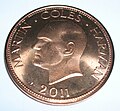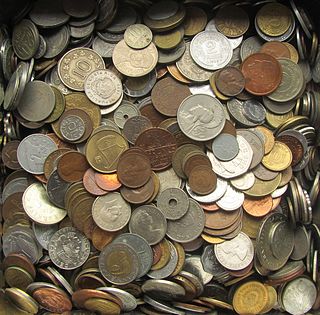
A coin is a small object, usually round and flat, used primarily as a medium of exchange or legal tender. They are standardized in weight, and produced in large quantities at a mint in order to facilitate trade. They are most often issued by a government. Coins often have images, numerals, or text on them. The faces of coins or medals are sometimes called the obverse and the reverse, referring to the front and back sides, respectively. The obverse of a coin is commonly called heads, because it often depicts the head of a prominent person, and the reverse is known as tails.

Lundy is an English island in the Bristol Channel. It forms part of the district of Torridge in the county of Devon.
Coins of the United States dollar – aside from those of the earlier Continental currency – were first minted in 1792. New coins have been produced annually and they comprise a significant aspect of the United States currency system. Circulating coins exist in denominations of 1¢, 5¢, 10¢, 25¢, 50¢, and $1.00. Also minted are bullion, including gold, silver and platinum, and commemorative coins. All of these are produced by the United States Mint. The coins are then sold to Federal Reserve Banks which in turn put coins into circulation and withdraw them as demanded by the United States economy.

The standard circulating coinage of the United Kingdom, British Crown Dependencies and British Overseas Territories is denominated in pennies and pounds sterling, and ranges in value from one penny sterling to two pounds. Since decimalisation, on 15 February 1971, the pound has been divided into 100 pence. Before decimalisation, twelve pence made a shilling, and twenty shillings made a pound.

The history of the English penny from 1154 to 1485 covers the period of the House of Plantagenet, up to the Battle of Bosworth Field which brought about the beginning of the Tudor period. The Plantagenet era saw an overall rise in quality of the coinage but saw a decline in the number of mints used to produce coins.

The history of the English penny from 1485 to 1603 covers the period of the House of Tudor up to the death of Elizabeth I without an heir. The Tudor era saw the debasement of the penny under Henry VIII and Edward VI, with Elizabeth I's reign overseeing the recovery of the silver quality. Under the Tudors, the penny decreased in size.

The history of the English penny from 1603 to 1707 covers the period of the House of Stuart, up to the Acts of Union of 1707 which brought about the Union of the Kingdom of England with the Kingdom of Scotland.

The penny of Great Britain and the United Kingdom from 1714 to 1901, the period in which the House of Hanover reigned, saw the transformation of the penny from a little-used small silver coin to the bronze piece recognisable to modern-day Britons. All bear the portrait of the monarch on the obverse; copper and bronze pennies have a depiction of Britannia, the female personification of Britain, on the reverse.

The five pound British gold coin, also known as a quintuple sovereign, has a nominal value of five pounds sterling. It has been struck intermittently since 1820, though as a circulation coin only in 1887, 1893 and 1902. Through most of its history, it has depicted, on its reverse, Benedetto Pistrucci's portrayal of St George and the Dragon, which has traditionally been used on the sovereign, or one-pound gold coin.

The Birmingham Mint was a coining mint and metal-working company based in Birmingham, England. Formerly the world's largest privately owned mint, the company produced coins for many foreign nations including France, Italy, China, and much of the British Empire during the 19th century.
The British farthing was a British coin worth a quarter of an old penny. It ceased to be struck after 1956 and was demonetised from 1 January 1961.

Martin Coles Harman was an English businessman who, in 1925, bought the island of Lundy.
This glossary of numismatics is a list of definitions of terms and concepts relevant to numismatics and coin collecting, as well as sub-fields and related disciplines, with concise explanations for the beginner or professional.

The Magdalen Island penny token was a token that was originally issued for use on that island and throughout Lower Canada and the Maritime Provinces in the early 19th century. This token was issued in 1815 by Sir Isaac Coffin, who was granted the island by the British government in reward for his loyalty to the crown during the American Revolutionary War. While not a rare coin, it is hard to find in anything but worn condition, and even prices for pieces in the lowest grades tend to start at about at about C$100 and go up rapidly from there.

Conder tokens, also known as 18th-century provincial tokens, were a form of privately minted token coinage struck and used during the later part of the 18th century and the early part of the 19th century in England and Wales, Scotland, and Ireland.
A coin was issued for circulation in Connaught during the reign of King Edward VI of England (1547–1553). It is a contemporary forgery of the extremely rare English shilling of that reign. It was struck in brass, and, occasionally, in copper. This interesting coin was known by the nickname 'Bungal', whose origin is not yet known. It circulated as a 1 penny coin.
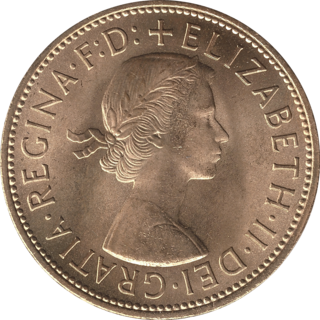
The British pre-decimal penny was a denomination of sterling coinage worth 1⁄240 of one pound or 1⁄12 of one shilling. Its symbol was d, from the Roman denarius. It was a continuation of the earlier English penny, and in Scotland it had the same monetary value as one pre-1707 Scottish shilling. The penny was originally minted in silver, but from the late 18th century it was minted in copper, and then after 1860 in bronze.
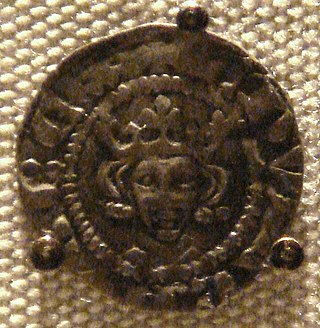
The English farthing was a coin of the Kingdom of England worth 1⁄4 of a penny, 1⁄960 of a pound sterling. Until the 13th century, farthings were pieces of pennies that had been cut into quarters to make change. The first English farthing coins were minted in the 13th century, and continued to be struck until the early 18th century, when England merged into the Kingdom of Great Britain in 1707.

The double sovereign is a gold coin of the United Kingdom with a face value of two pounds sterling (£2). Rarely issued in the first 150 years after its debut in 1820, it never had a significant presence in circulation. It became a collector and bullion coin, and has been struck most years since 1980. It features the reigning monarch on its obverse and, most often, Benedetto Pistrucci's depiction of Saint George and the Dragon on the reverse.
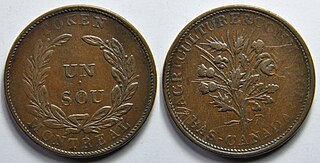
Bouquet sou were a series of tokens that were created for use primarily within Lower Canada in the mid- to late-1830s. Roughly equivalent in value to a half penny, the "bouquet sou" were so called because they displayed a group of heraldic flowers tied together with a ribbon on their obverse. The group of flowers were encircled by one of several legends, which might say "Trade & Agriculture / Lower Canada", "Agriculture & Commerce / Bas Canada" or some variant of these that might also substitute the name of the issuing bank. The other side most typically gave the denomination of "un sou", surrounded by a wreath and the words "Bank Token" and "Montreal". There are a large variety of these tokens, distinguished primarily by the number and variety of flowers that appear in the "bouquet", along with the differences in the legends that appeared on either side of the token. They were initially issued by the banks of Lower Canada, and were later imitated by speculators who produced tokens that looked similar, but were underweight for their denomination. These coins also circulated to Upper Canada, as at least one archeology dig attests. Large numbers of these tokens were produced and many examples can easily be obtained for only a few Canadian dollars, though a few rare varieties can command significantly higher prices.










